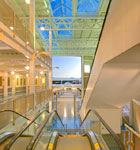First impressions count. And though most cities promote themselves with a show of skylines, museums, and convention centers, the opening act often is the airport and its car-rental facilities. This is well understood by Wesley Wong, principal of Demattei Wong Architecture (DWA), whose firm has designed 37 consolidated-rental-car facilities, or CRCFs, throughout the United States. Wong talked to gb&d about the art, function, and sustainability of arrivals and departures.

To conserve energy, this car-rental facility foregoes air conditioning and uses large skylights and building openings to bring in daylight.
gb&d: You primarily work in a special subset of airport design, that of car-rental facilities. What are key factors that influence this task?
Wesley Wong: It is the responsibility of the architect to reflect the spirit of the airport and the region it serves. It involves an inordinate amount of research to understand what makes a place special—cultural impacts such as the people, the land, and the arts.
Your work on the Nashville airport has garnered attention for being green. How can a depot for cars and SUVs be environmentally friendly?
Wong: We can control the product that supports the cars, the processes, and the physical building itself. By placing all car rental operations in a single facility adjacent to the Nashville International Airport—providing 2,400 stalls in approximately 900,000 square feet on three levels—we eliminate more than 800,000 miles per year in shuttler traffic that would otherwise connect to remote off-airport sites. Additionally, the quick turn-around facility provides 14 carwash bays, where the water is recycled using a reclaim system, reusing more than 90 percent of the water per wash.
The open-air customer core was designed to take advantage of natural daylight—minimizing the use of energy in the three-story space—through the use of large skylights, building openings, and no air conditioning.
No air conditioning? In Nashville?

This splayed concrete panel façade, designed by Demattei Wong for the Nashville airport’s consolidated car-rental facility, helps provide natural light to the three story space.
Wong: Yes. It doesn’t make sense to transition people from the terminal through an open-air walkway, back into a temperature-controlled area, then back to an unconditioned space. The core is a transition space, not a place where customers congregate. The west wall of the facility was designed with a 200-foot-long, 45-foot-high green screen, a sustainable, landscaped façade that allows airflow but blocks the afternoon sun.
You’re working to get all of your 30 employees LEED accredited. How important is it for everyone in your firm to achieve that?
Wong: DWA has a mandate to have all of our employees LEED accredited. We believe that good, practical, and responsible design is the foundation of sustainability, and that in the future, every new building will be required to be LEED [certified]. We want DWA to be leading the effort. Understand that we work in a constantly changing industry, and sustainability is part of the change. We work across the country and have to be adaptable and look to alternative methods, relying on KPFF Consulting Engineers, for example, as they work with us on the LEED Silver Seattle-Tacoma International Airport consolidated-rental-car facility. Ultimately, we need to provide responsible architecture and do it well and effortlessly.

